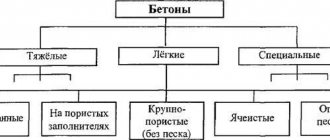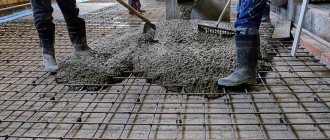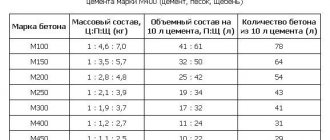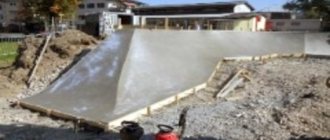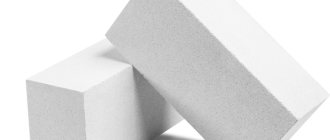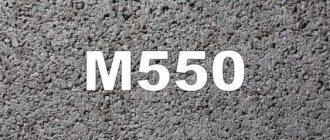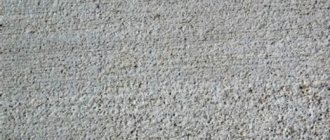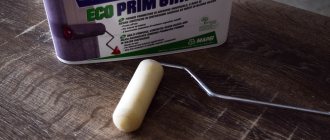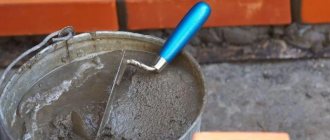General description and differences
Cement mortar made from conventional components, like other mortars in which a mineral substance acts as a binder, has a number of disadvantages. Among them, low tensile or bending strength, low impact resistance, low percentage of deformation, low abrasion resistance and poor adhesion to other building materials stand out. The list of disadvantages is quite long, which greatly limits the use of a conventional solution. In order to reduce the influence of these shortcomings as much as possible or completely eliminate their influence, special polymers are introduced into the mixture as an additive from 2 to 30% of the total mass. Thus, we can say that the composition of the polymer cement mortar differs from the usual one only by the presence of this very additive.
Technical composition of the solution
Polymer cement mortar for concrete consists of certain compositions suitable for decorative finishing. They include:
- Mineral binder product;
- High calcium ash;
- Portland cement;
- Low fired clay;
- Fillers;
- Latex;
- Water.
When choosing other manufacturers, the composition may vary slightly. Compared to conventional cement mortar, such mixtures have a finely porous structure, increased extensibility, resistance to bending and adhesion. If the addition of polymers to cement is done correctly, the mixture is saturated with properties for less shrinkage.
Most polymer additives have an air-entraining function. Therefore, when mixing such a solution, oxygen penetrates into the composition and the polymer-cement solution is saturated with air, becoming more porous than conventional cement mixtures.
Penetrating into the pores of the composition, polymer additives narrow them, which is why a fine-grained structure is achieved. The polymer has a strong astringent; it connects the filler and cement, while strengthening the future stone.
Introduction of polymer into mixtures
It is worth saying that the polymer, one way or another, is introduced into a large number of different mixtures. Most often, it is intended only to improve plasticization, as well as hydrophobization. In addition, the presence of such additives is less than 1% of the total mass. This is the main difference from a full-fledged polymer cement mortar. In them, the polymer seriously affects the composition, changing its physical and chemical properties, its structure, and also enters the solution as an independent element, and not a regular additive.
Methods for adding polymers may vary. For example, you can add it in the form of an aqueous mixture. In such cases, usually its content in cement will be no more than 3-5% of the total mass. Much more commonly used is a method that involves aqueous dispersions containing polymers. The difference is that in a dispersion the polymer does not dissolve in water, which means its amount can be increased. Thus, it is possible to introduce approximately 10-20% of the additive from the total mass of cement into the cement mixture.
Polymer-cement compositions for floors and screeds
Page 1 of 4Next ⇒
LECTURE No. 2
Assembly and masonry mixtures occupy a leading place in the total production of dry mixtures.
They are made on the basis of binders (cement, lime, etc.), fillers (quartz or lime sand) and various chemical additives (plasticizers, etc.).
Classification of cement-based masonry mortars:
A – for ordinary bricks or blocks;
B – special adhesive for laying thin-walled blocks, heat-insulating and silicate bricks;
C – with thermal insulation properties.
Compositions of masonry mortars
| Component | Content of components in the compositions, % | ||
| A | IN | WITH | |
| Portland cement PC grade 500 | 15-20 | 20-25 | 30-50 |
| Fillers (quartz sand or limestone filler, fraction 0.05-2.5 mm) | 85-74,9 | 77,7-65,4 | 59,95-8,9 |
| Distribution of quartz sand by fractions, mm: | |||
| 0,05-0,125 | 10% | 30% | 20% |
| 0,125-0,25 | 10% | 50% | 20% |
| 0,25-0,5 | 20% | 20% | 10% |
| 0,5-1,0 | 35% | — | 25% |
| 1,0-2,5 | 25% | — | 25% |
| Hydrated lime | 0-5 | 0-5 | 0-5 |
| Lightweight fillers (e.g. perlite, polystyrene, vermiculite) | _ | _ | 10-35 |
| Methylcellulose | 0-0,1 | 0,3-0,6 | 0,05-0,1 |
| Additives (e.g. air entraining agent, set accelerators) | 0-0,05 | 0-0,05 | 0-0,05 |
| Redispersible polymer powder | — | 2-4 | 0,5-1 |
Compositions of masonry mortars
| Component | Content of components in the compositions, % | ||
| Masonry mixture (economical) | General purpose masonry mixture | Masonry mixture for installation of aerated concrete blocks | |
| Portland cement PC grade 500 | 15-20 | 12-20 | 30-40 |
| Fillers (quartz sand or limestone filler, fraction 0.05-2.5 mm) | 75-85 | 60-80 | 55-65 (quartz sand only) |
| Hydrated lime | — | 0-6 | 4-6 |
| Methylcellulose | 0,01-0,03 | 0,02-0,04 | 0,3-0,4 |
| Blowing agent | 0,01-0,03 | 0,02-0,05 | 0,3-0,4 |
| Redispersible polymer powder | — | 0,5-1 | 1-2 |
The compressive strength of masonry mortars depends on their purpose. The solution correction time is at least 7 minutes, working time is at least 2 hours.
Dry mixtures for flooring are divided into mixtures for screeds and mixtures for facing. The tasks performed by the screed material are to level the base of the floor under the facing covering and transfer the load from the covering to the base. Mixtures used as a topcoat must have high strength properties, wear resistance and low porosity.
Self-leveling mixtures are effective for screeds and floor coverings. After mixing with water and intensive mixing, thanks to the combined action of plasticizing and water-retaining additives, they have the properties of a “liquid body” and can spread under the influence of their own weight, forming a flat horizontal surface.
Compositions of dry mixtures for screed are intended for the installation of floors with a thickness of 10-80 mm. High-quality quick-hardening Portland cement with a strength after 24 hours of hardening of at least 20 MPa is used as the main mineral binder. The filler used is quartz sand with a maximum grain size of 2.5 mm. The optimal ratio of Portland cement and aggregate in the screed is 1:2-1:3. Limestone flour, ground marble, and hydrated lime are used as fillers. The mixture also includes modifying additives - defoamers, superplasticizers, water-retaining additives.
Compositions of dry mixtures for finishing floor surfaces are characterized by high mobility, quickly gain strength and do not require grinding of the hardened surface. The thickness of the coating is 1-10 mm. Coating mixtures may include Portland cement, aluminous cement, calcium sulfate and hydrated lime. Fine quartz or marble sand with a maximum particle size of 0.315 mm is used as filler. The ratio between binder and filler is 1:1-1:1.5. Modifying additives: redispersible polymer powders, water-retaining additives, super- or hyperplasticizers, defoamers, hardening accelerator.
Polymer-cement compositions for floors and screeds
| Component | Content of components in the compositions, % | ||
| A | IN | WITH | |
| Portland cement PC grade 500 | 30-35 | 25-35 | 0-15 |
| High aluminate cement | — | 3-8 | 20-30 |
| Gypsum grade G-7 | — | 1-4 | 12-20 |
| Quartz sand (0-0.4 mm) | 58-39,35 | 58-27,33 | 55,43-7,33 |
| Distribution by fractions, mm: | |||
| 0,05-0,125 | 10% | 30% | 70% |
| 0,125-0,25 | 40% | 65 % | 30 % |
| 0,25-0,4 | 50% | 5% | — |
| Carbonate filler within 20 microns or fly ash | 10-20 | 10-20 | 10-20 |
| Hydrated lime fraction no more than 0.2 | 0-2 | 0-2 | 0-2 |
| Superplasticizer (synthetic or casein) | 0,5-1 | 0,5-1 | 0,5-1 |
| Methylcellulose | 0,05-0,1 | 0,05-0,1 | 0,05-0,1 |
| Redispersible polymer powder | 1-2 | 2-3 | 3-4 |
| Antifoaming agent | 0,05-0,3 | 0,05-0,3 | 0,05-0,3 |
| Setting accelerator | — | 0-0,2 | 0,1-0,2 |
| Additives (reinforcing and surfactants) | — | — | 0-1 |
Classification of polymer-cement compositions for floors and screeds:
A - ordinary leveling, for repair work on a small area, applied manually;
B – quick-setting self-leveling sublayer for large surfaces with a thickness of 15 mm;
C is a quick-setting, high-quality self-leveling compound used on large surfaces with a thickness of 5 to 10 mm.
Requirements for mixtures for flooring:
- quickly gain strength (technological passage - after 8 hours, light loads - after 72 hours for group B and, accordingly, after 3 hours - for group C);
- have high abrasion resistance for group C (abrasion resistance - no more than 0.7 g/cm2);
— be frost-resistant (at least 75 cycles) in unheated rooms and outdoors;
— ensure the necessary solidity of screeds, interlayers and coatings due to high adhesion between layers.
Self-leveling polymer floors are seamless facial thin-layer coatings designed for large areas. Self-leveling floors are produced based on liquid-viscous oligomers: epoxy, polyester, polyurethane and other liquid rubbers and elastomers. To ensure a decorative effect and improve the physical and mechanical properties of the coating, powdery and flake fillers and pigments are introduced into them. Self-leveling floors can be hard (less than 1 mm thick) and elastic (rubber-like, 1-3 mm thick). Such floors are made on a solid, dense and durable base or screed. The requirements for evenness and cleanliness of the base are very high. Base moisture content is not more than 5%. Floors are easy to clean and decontaminate and are resistant to most chemicals.
Compositions for repair work . Sealing compounds are used to repair and restore small surfaces. They are not expected to perform load functions. Such compositions must have good technological properties, adhesion to mineral bases, high wear resistance and abrasion strength, low shrinkage and sufficient elasticity.
Concrete restoration solutions for the repair and rehabilitation of reinforced concrete structures are used to restore concrete structures and their load-bearing capacity, to protect steel reinforcement from corrosion, to ensure wear resistance of the entire structure, and protection from weather conditions and the environment.
A - simple sealing, for unreinforced concrete, used for sealing cracks, cavities, holes, voids, etc.;
B – high-quality, for reinforced and load-bearing structures, including those operating under dynamic load.
1Next ⇒
Recommended pages:
Use the site search:
Additional items
It is worth noting that all the characteristics of a polymer cement solution can be lost if a process such as coagulation or curdling of the solution occurs during the addition of a polymer dispersion. Most often, to avoid such negative consequences, various stabilizers are used. They usually choose surfactants (surfactants) - OP-7 or OP-Yu. It is also possible to replace them with a small group of electrolytes, for example, liquid glass. Only a polymer-cement mortar, which was mixed based on a plasticized PVA dispersion, can do without the addition of a stabilizer.
However, the introduction of surfactants does not pass without a trace. Most often, these substances act as powerful foaming agents, and they are also capable of drawing air into the mortar mixture. If this happens, then the smallest air bubbles that were involved can reach 30% of the total mass of the solution.
Changing the properties of the solution
The presence of polymer additives in the solution helps to distribute the pores more evenly, as well as make their volume much smaller. You can give an example. In ordinary cement mortar, for example, pores can be up to 1 mm in diameter, and their main part is 0.2-0.5 mm in volume. If we are talking about a polymer-cement composition, then the maximum volume is reduced to 0.5 mm, and the largest amount, approximately 90-95%, will not be more than 0.2 mm at all.
This speaks in the most positive way, for example, when completely leveling wall plaster with a polymer-cement mortar, where pores could disrupt the overall structure. It is also worth adding here that those mixtures in which there is entrained air are characterized by greater plasticity, as well as better workability with a lower liquid content. As mentioned earlier, plasticization in such compositions is also at a higher level. All this leads to the fact that when adding water it is very important to take into account the percentage of entrained air and the plasticization of the polymer cement mortar.
Technology for constructing polymer-cement coatings “Plastobeton-V”
Possible types of polymer cement (hereinafter referred to as PC) coatings: 1. PC sand concrete M500 (for vibrating lath). 2. PC sand concrete M400 is self-compacting. 3. PC mortar M400 self-leveling (self-leveling floor).
The thickness of the coating should be: For light loads – 5-7 mm. For moderate loads – 8-15 mm. Minimum thickness – 4 mm.
To produce PC mortars (sand concrete), the following should be used: 1. Cement grade M400, M500 and more, gray or white (for colored coatings), unplasticized, without additives (marking - D0); 2. Washed sand of the 1st class (dust content - no more than 3%), MKR (fineness modulus) = 2.0 or more. 3. Cement modifier “Politax” Plastobeton-V (hereinafter referred to as Additive).
Coating installation work can be carried out at a base temperature of +5 to +35 C.
Foundation requirements. 1. Concrete or sand-cement screed M200 or more. 2. The surface must be dry, not oily, without flaking or “breathing” areas. 3. Vertical movements of the base, with the exception of expansion joints, are not allowed.
Preparing the base. 1. Removal of flaking and oily areas and water. 2. Removal of protruding foreign bodies and milling of severe irregularities. 3. Installation of an elastic ligament (PE, waterproofing) at junctions with vertical structures (walls, columns, etc.). 4. Preliminary cleaning of the surface. 5. Joining cracks for further puttying.
Guide device. The gripper map must be designed taking into account: 1. The length of the vibrating slats or rules. 2. Location of expansion and expansion joints of the base. 3. Location of extended shrinkage cracks in the base. 4. Location of vertical load-bearing structures in the room. The guides must be laid parallel to one straight line and perpendicular to the direction of the greatest temperature differences. All expansion and expansion joints of the base must be transferred to the surface of the coating; to do this, it is enough to mark their location with a marker on the walls or columns. If possible, install guides over the seams, otherwise, cut the seam along the markers to the entire depth of the coating.
Work order. 1. Mark the position of the guides on the base plane. 2. At the place where the guides are laid, drill dowels with self-tapping screws (length approx. 30mm) in increments of no more than 5 m. 3. Pull the twine between the screws and bring all the twines into the required plane, taking into account the minimum and average thickness of the coating. 4. Perform a final cleaning of the base surface under twine 15-20 cm wide. 5. Prime the cleaned surface with concrete contact compound according to the instructions. If there are cracks in the base, embroider them too and prime the inner surface. 6. Apply polymer cement mortar to the surface primed with concrete contact. 7. Sink the guides into the applied mortar so that the top edge touches the stretched twine, the area between the guide and the base is filled with mortar, the distance between the top edge and the mortar is at least 4 mm. 8. Fill the cracks with mortar. 9. After the mortar has set, apply concrete contact to its surface in order to prevent drying out in the early stages of hardening.
After the polymer-cement mortar has gained sufficient strength (12-36 hours), you can begin laying the base composition. Clean the appropriate grips and apply concrete contact primer according to the instructions. Laying should be done “through the strip”.
1. PC sand concrete M500, mobility P4. It is carried out similarly to laying ordinary sand concrete under a vibrating screed, without the use of concrete finishing machines (helicopters).
2. PC sand concrete M400, mobility P5. It is carried out similarly to laying self-compacting sand concrete, usually without the use of concrete finishing machines (helicopters).
3. Self-leveling PC mortar M400 (Self-leveling Floor). It is carried out similarly to the installation of other self-leveling dry mixtures (Vetonit, Horizon), with the obligatory rolling with a needle roller.
Wetting the surface of the composition to be laid, as well as diluting it with water after preparation, is NOT allowed!!! Immediately after setting, protect the surface of the coating from drying out with polyethylene film!!!
Upon reaching the required strength for grinding (approximately: at 30°C - 12 hours, at 20°C - 24 hours, at 10°C - 48 hours), cut the seams to a depth of 1/3 of the coating thickness. Start sanding the coating. Sanding is performed without wetting the surface with water. Immediately after finishing the grinding stage, it is necessary to clean the surface from sludge and cover it with plastic film! 1. Grinding with diamonds (315/250) or medium abrasive corundum (80-120). 2. Polishing with corundum No. 40 or No. 25 until shiny. It is recommended to carry out polishing no earlier than three days after installation. After completing all the work, fill the open seams with polyurethane sealant. By agreement with the customer, the surface can be polished or coated with polyurethane varnish.
Basic principles of preparing a polymer-cement composition. 1. The amount of water, taking into account the free water of sand, should be less than 30 kg per 100 kg of cement. 2. Consistency of the composition: P4 – “plastic, viscous-flowing”, easily compacted; P5 – plastic, fluid, self-compacting. 3. The surface after compaction with a vibrating screed: flat, smooth, homogeneous without traces of separated moisture. 4. Self-leveling PC mortars (self-leveling floors) should be prepared on sand with an MCR of no more than 2.5. The required consistency is selected by varying the amount of sand with the maximum amount of water (30 kg per 100 kg of cement). The criterion for a correctly selected composition can be pouring onto a horizontal plastic surface - the thickness of the solution after self-flowing should be 3-4 mm. Sand supplied in bulk and stored outside contains free water. It must be taken into account when selecting a recipe. Wet sand of medium coarseness contains about 3 liters of free water per 100 kg, very wet sand - up to 6 liters.
Examples of P5 sand concrete recipes for sand MKR = 2.5. 1. Sand is dry, free water content = 0%. Water 30 kg, dry sand 250 kg; 2. Sand is wet, free water content = 3%. Water (30 – 250x0.03) = 22.5 kg, wet sand 250 + (30-22.5) = 257.5 kg; Other components: Additive 30 kg, cement M500DO 100 kg.
Recipes depending on sand fineness modulus (MKR)
| MKR | Cement, kg | PC sand concrete 500, mobility P4 | PC sand concrete M400, mobility P5 | Self-leveling PC mortar M400 | |||
| Sand, kg | Water, kg | Sand, kg | Water, kg | Sand, kg | Water, kg | ||
| 2,2 | 100 | 220 | 21-24 | 220 | 24-30 | 180 | 27-30 |
| 2,5 | 100 | 250 | 21-24 | 250 | 24-30 | 210 | 27-30 |
| 2,8 | 100 | 280 | 21-24 | 280 | 24-30 | Do not use! | |
| 3 | 100 | 300 | 21-24 | 300 | 24-30 | Do not use! | |
Comment: the higher the MCR of sand, the cheaper the PC solution (sand concrete)
The procedure for preparing the first (trial) batch of polymer cement.
1. Pour the calculated amount of Additive into the container, add half the calculated amount of water. 2. Turn on the mixer (600-1000 rpm). 3. Add the calculated amount of cement and mix until smooth. 4. Enter the calculated amount of sand, mix until smooth. 5. Slowly add water in portions (no more than the remainder of the calculated amount) to the desired consistency. 6. Add the remaining water for the final calculation and recalculate the water for the standard batch. 7. Lay within 40 minutes (self-leveling - within 5 minutes).
The procedure for preparing a standard batch of polymer cement.
1. Pour the calculated amount of Additive, add the calculated amount of water. 2. Turn on the mixer (600-1000 rpm). 3. Add the calculated amount of cement and mix until smooth. 4. Enter the calculated amount of sand, mix until smooth. 5. Lay within 40 minutes (self-leveling - within 5 minutes).
Attention: sand, cement and water must be weighed on scales!
Composition of the polymer-cement mortar for the installation of guides (if required). Water 15-17 kg; dry sand MKr-2.5 250 kg; cement 100 kg; Additive 30 kg. The required consistency is rigid-plastic, not fluid (close to plaster mortar). The preparation procedure is similar to polymer cement. If the mixture turns out to be too mobile, do not add cement or sand, but spread it under the twine and let it thicken for about 40-60 minutes.
Adhesive properties
Such compositions exhibit increased adhesion, which is explained as follows. When applying the mixture, the polymer concentrates at the interface and acts as an adhesive base between the solution and the base. As for the adhesion itself, it directly depends on the type of added polymer, as well as its concentration. Next, it is worth saying that this property manifests itself only when the solution is dried under air-dry conditions. Therefore, for example, plaster with a polymer-cement mortar applied to the walls will be an excellent basis for installation. If hardening occurs in water, then adhesion will not work as well, even with a huge concentration of polymer. This is due to the fact that stabilizers dissolve in water, and some additives are even capable of changing their properties if they are in a liquid medium.
It can be added that a high level of adhesion affects not only improved adhesion to other materials, but also the mechanical characteristics of the solution itself. This is especially noticeable when tensile and bending loads occur. For mixtures with additives, these indicators are approximately 10 times higher than for conventional ones. This is due to the fact that the polymer layers bind the mineral components together. There is also such a characteristic as the elastic modulus, which is about 10 times lower than the usual one. Thanks to this fact, we can safely say that the polymer composition is more deformable than an ordinary one.
Fundamentals of polymer cement concrete and plastic concrete technology
Polymer-cement concrete is an artificial stone material, the binders of which are polymer and cement, and the fillers are sand and crushed stone. Unlike conventional concretes with modifying additives (GKZh-94, Winsol), which, due to small quantities, practically do not change the structure of concrete, the polymer content in polymer-cement concretes is quite high. This makes it possible to obtain materials with new properties. They have less weight, are frost-resistant, have slightly greater strength than conventional ones, and have increased wear resistance. Polymer-cement concretes are produced in three ways: by introducing into concrete by mixing aqueous dispersions of polymers (polyvinyl acetate or synthetic rubber), which disintegrate in the concrete mixture with the release of water, while the dehydrated polymer acts as an additional binder; by adding water-soluble monomers and polymers (furan and polyvinyl alcohols, epoxy, phenol-formaldehyde resins, etc.) to the mixing water, followed by their curing in concrete by heating or using hardeners; impregnation of concrete to the required depth with low-viscosity polymers (urea, ethinol varnish, styrene), which cure directly in the concrete. Fillers for polymer-cement concrete are quartz or crushed sand, as well as crushed stone of strong and dense rocks with a particle size of no more than 20 mm. Polymer cement fine-grained mortars are also used. The optimal content of a polymer such as polyvinyl acetate is from 15 to 20% by weight of cement in terms of dry matter. This makes the best use of the properties of both cement and polymer. With this dosage, the continuity of the cement gel is maintained in polymer-cement concrete, and the polymer, enveloping the cement joints and aggregate grains, additionally glues them together. As the polymer increases, the continuity of cement new formations is disrupted, which reduces the strength of polymer-cement concrete. The optimal content of water-soluble urea polymer S-89, as well as epoxy polymers DEG-1 and TEG-17, is about 2% relative to the weight of cement. In this case, the water-cement ratio of the concrete mixture can be reduced to 0.29-0.30 without compromising its workability, as well as durability in aggressive environments. By using various polymer components, it is possible to obtain polymer concretes that are resistant to petroleum products, fats and salt solutions. Polymer-cement concretes are used for the construction of wear-resistant floors, airfield pavements, tanks for oil products, as well as monolithic structures for work in aggressive environments. To prepare polymer cement mixtures, paddle mixers or vibrating mixers are used. During mechanical mixing, the mixture is saturated with air, and small pores are formed in the concrete, evenly distributed throughout the volume. Due to the fact that polymer-cement concrete is still used in small volumes, their mixtures are prepared in mixers located near the place of installation. Polymer-cement mixtures have high viscosity, so vibrating them at low frequencies (3000 kol/min) is ineffective. Air is not removed from the concrete, its structure becomes excessively porous and loose. High-frequency vibration is more appropriate, and for hard mixtures, compaction and vibrocompression. Polymer-cement concretes prepared with aqueous dispersions of polymers are kept in air-dry conditions, while concretes with additives of epoxy and urea polymers quickly harden in humid conditions. Plastic concretes are artificial conglomerates produced entirely using organic polymer binders. They are essentially plastics with mineral fillers of varying sizes. The binders in plastic concrete are low-viscosity thermosetting polymers (phenol-formaldehyde, furan, polyester and epoxy), which, with the addition of hardeners and under certain conditions, harden, gluing the components into a strong conglomerate. Typically, plastic concrete with compositions 1:5–1:15 (polymer: filler by weight) is used. To cure polymers, Petrov's kerosene contact, sulfonic acids and mineral acids, polyethylene polyamine, diethylenetriamine, etc. are used. Clean sands with a grain size of 0.6-2.5 mm and a content of clay and dust particles of no more than 0.5% are used as fillers. Crushed stone and gravel must also be dry and clean and have a particle size of no more than 20 mm. In addition to crushed granite, andesite and barite, as well as crushed tripoli and graphite are used as fillers, depending on the purpose of the plastic concrete. The strength properties of plastic concrete are determined by the properties of the binder and filler, as well as the adhesion between them. Plastic concrete has high strength, especially in tension and bending. Thus, the flexural strength of some plastic concretes based on epoxy polymers reaches 350-450 kgf/cm2. Plastic concrete is practically waterproof and frost-resistant; They resist wear well and are resistant in aggressive environments. For example, their resistance to acids is 10 times higher than that of conventional concrete. It is advisable to use plastic concrete for waterproofing and anti-corrosion linings. They are used to produce wear-resistant floors, in airfield pavements, as well as for the construction of parts of buildings and structures operated in aggressive environments. Plastic concrete mixtures are prepared in small volumes directly at the places where they are laid due to their rapid hardening. Fillers are loaded into the paddle mixer, then polymer binders. After 3-4 minutes of mixing and obtaining a uniform mass, add the hardener and mix for 5-8 minutes. The prepared portion of the mixture is immediately put into the case. It is compacted by compaction or bayonet. Plastic concrete hardens better in dry conditions at 50-100° C. An increase in relative humidity above 60% reduces the strength of plastic concrete, especially on polyester polymers. Compositions based on epoxy polymers are less sensitive to high humidity. The heating time of laid plastic concrete is 4–8 hours, depending on the type of polymer and the composition of the mixture. When plastic concrete hardens, it shrinks, the amount of which depends on the type and amount of polymer.
Shrinkage and other characteristics
If more than 7-10% of the polymer from the total mass of cement is introduced into the mixture, then when it hardens, more significant shrinkage will be observed. However, since at the same time the deformability of the solution also increases greatly, then in terms of such characteristics as resistance to cracks, the mixture is in no way inferior to the usual one, and in some situations may even exceed it. Another difference in parameters is moisture release. In a polymer solution it occurs more slowly, which has a positive effect on the hardening process, since rapid drying is not observed, which can cause cracks.
Interaction with other materials
What is polymer cement mortar used for? All of the above properties and characteristics of the material have led to the fact that it is excellent for fastening facing materials, as it can provide better fastening. Here you can make a simple comparison between a regular mixture and a mixture with a polymer additive. A solution based on cement and sand creates maximum fastening strength 7-9 days after lining, and by 28 days this figure will decrease by approximately 5-6 times. If we are talking about a solution with a polymer additive, then the maximum fastening strength will be achieved a little later, on days 9-10, but its absence in the future is not observed at all. Thanks to this quality, such compositions have become widely used for cladding.
polymer cement mortar
Patent search by IPC-8 classes:
Class C04B26/02 high-molecular compounds
RF patents in class C04B26/02:
| copolymer admixture system for preserving the workability of cement compositions - patent 2526461 (08/20/2014) | |
| polymer composite material and method for its production - patent 2509064 (03/10/2014) | |
| redispersible polymer powder - patent 2501819 (12/20/2013) | |
| wet molding substrate with a high degree of sound absorption - patent 2482084 (05.20.2013) | |
| raw mixture for the manufacture of thermal insulation materials - patent 2458016 (10.08.2012) | |
| composition for protective coating of concrete - patent 2455265 (07/10/2012) | |
| method for producing a polymer composition for artificial marble chips having a high specific gravity and a high refractive index - patent 2414493 (03/20/2011) | |
| nanostructuring binder for composite building materials - patent 2408552 (10.01.2011) | |
| artificial marble containing three-dimensional translucent marble chips, and a method for its production - patent 2371410 (10/27/2009) | |
| design of the internal walls of a building using dry wall panels and the connecting material used to cover the walls - patent 2365552 (08/27/2009) | |
Class C04B26/04 obtained by reactions involving only unsaturated carbon-carbon bonds
Russian Federation patents in class C04B26/04:
| composition for thermal insulation of building structures - patent 2525536 (08/20/2014) | |
| putty mass - patent 2491244 (08/27/2013) | |
| method for producing thermoplastic concrete (options) - patent 2481290 (10.05.2013) | |
| polymer-mineral solution for impregnation of a frame made of mineral filler - patent 2429266 (09/20/2011) | |
| fire-resistant composite panel - patent 2422598 (06/27/2011) | |
| polymer solution mixture - patent 2417962 (10.05.2011) | |
| polymer concrete mixture - patent 2402501 (10.27.2010) | |
| polymer concrete mixture - patent 2394786 (07/20/2010) | |
| artificial marble containing three-dimensional translucent marble chips, and a method for its production - patent 2371410 (10/27/2009) | |
| road building material (variants) - patent 2361836 (07/20/2009) | |
Class C04B28/04 Portland cements
RF patents in class C04B28/04:
| raw material mixture for the manufacture of material imitating natural stone - patent 2528810 (09.20.2014) | |
| dry construction mixture - patent 2528774 (09.20.2014) | |
| method for preparing lightweight masonry mortar and composition for lightweight masonry mortar - patent 2528323 (09/10/2014) | |
| composite building material - patent 2526083 (08/20/2014) | |
| concrete mixture - patent 2525565 (08/20/2014) | |
| concrete mixture - patent 2525078 (10.08.2014) | |
| raw mixture for concrete production - patent 2524699 (08/10/2014) | |
| raw mixture for the production of fine-grained concrete - patent 2522589 (07/20/2014) | |
| fast-acting concrete mixture for repair of building structures - patent 2522588 (07/20/2014) | |
| concrete mixture - patent 2522569 (07/20/2014) |
Class C04B28/06 aluminous cements
RF patents in class C04B28/06:
| concrete mass - patent 2462435 (27.09.2012) | |
| solid mixture and coating based on sulfoaluminate or sulfoferroaluminate clinker and cement-based pipes coated in this way - patent 2448922 (04/27/2012) | |
| raw mixture for the manufacture of sculptures, fences, slabs - patent 2446124 (03/27/2012) | |
| refractory concrete mixture (options) - patent 2437862 (12/27/2011) | |
| mixture for producing a penetrating waterproofing joint compound - patent 2408553 (01/10/2011) | |
| non-fading cementitious mortar compositions - patent 2383508 (03/10/2010) | |
| composition for the production of especially strong and heavy concrete for protection against radiation - patent 2379246 (01/20/2010) | |
| additive for concrete mixture - patent 2377211 (12/27/2009) | |
| raw mixture for heat-resistant structural and thermal insulating concrete - patent 2356865 (05/27/2009) | |
| curable mixture containing lime, cementitious composition and polymer - patent 2345006 (01/27/2009) | |
The best compositions for work and consumption
By modifying conventional cement-sand mortar with plasticizers and polymers, a significant reduction in consumption can be achieved. The polymer-cement mortar can be applied in the thinnest layers and at the same time be a high-quality base for the facing material. This is due to the fact that dispersion with polymers not only seriously increases plasticity, but also involves air from 8 to 12%.
Today in this area, the most promising solution is considered to be one made on the basis of gypsum-cement-pozzolanic binder (GCPB), as well as aqueous dispersions of polymers. This composition can be used both for external work and for internal plastering. However, as practice has shown, the greatest effect is achieved when using it in decorative solutions and mastic mixtures for treating building facades.
Polymer cement waterproofing - groups of materials
About materials
In most cases, we use organic materials for waterproofing, such as bitumen-polymer, polymer mastics and roll materials.
Polymer-cement (or inorganic) waterproofing has not yet received sufficient use in construction, primarily due to the lack of effective waterproofing materials and technical solutions for their use. Polymer-cement waterproofing compounds have a number of advantages compared to bitumen mastics and roofing felts. Firstly, they are environmentally friendly and can be used indoors. Secondly, polymer-cement waterproofing is not subject to such rapid destruction as traditional organic waterproofing. They have high adhesion strength to various substrates (concrete, brick, wood, metal, etc.). Due to its high cohesive strength, polymer-cement waterproofing can withstand both static and dynamic loads. Due to the good vapor permeability of inorganic polymer-cement waterproofing, the problem of the formation of blisters and bubbles is eliminated; it can be applied to damp and wet surfaces (sometimes moistening the surface before applying the waterproofing polymer-cement material is a prerequisite). Inorganic cement waterproofing is characterized by high durability and maintainability, ease of use and high application productivity. All these advantages of polymer-cement waterproofing compositions over traditional mastics and roofing felts determine the scope of their application. They are used for walls of foundations and basements, water tanks, swimming pools (a very important feature is the ability to combine the functions of waterproofing and adhesive for facing tiles), walls and floors in wet rooms (car washes, bathrooms), surfaces of exploited terraces and balconies, and also for protecting building structures from exposure to aggressive environments (various acids).
Main range
- Lakhta coating waterproofing, Plast-Gidro, Hydromax-1 Rigid waterproofing composition provides the coating with its waterproofing and protective properties well. The composition is suitable for use on concrete, brick, cement and stone surfaces. A coating of rigid waterproofing allows leaking gases to pass through, as a result of which the base is able to get rid of water vapor, that is, to “breathe.” This waterproofing protects concrete structures from carbonization. Rigid polymer-cement waterproofing provides waterproofing of underground structures that are under the pressure of groundwater, even when applied to the inner surface of external walls (the so-called “negative waterproofing”: water works to separate the waterproofing membrane from the base). The rigid waterproofing compound is highly resistant to the corrosive effects of salt water and atmospheric pollutants. The coating forms structurally inextricable bonds with the base, as it fills and seals all pores. Rigid waterproofing compounds are used as a coating that prevents carbonation of concrete structures.
- Lakhta Elastic Waterproofing, Hydromax-2
An elastic, two-component waterproofing composition provides the surface with a flexible waterproof coating that covers shrinkage deformation and thin cracks. The elastic composition is used for waterproofing concrete, natural or artificial stone, plaster made from mortar, and brick. An elastic two-component composition is used to create a protective waterproofing layer of concrete surfaces from the aggressive effects of chemicals. Designed for waterproofing cement surfaces and bases before facing with ceramic tiles during both interior and exterior work and for waterproofing plastered surfaces with hairline cracks. - Hydrotex B Lakhta Water plug, Waterplug, Peneplug, Xypex Patch'n Plug, Plast-Plomba, Hydromax-300
Quick-setting waterproofing.
This waterproofing instantly stops water flowing from cracks, breaks and other openings in concrete and masonry. It sets within 3-5 minutes (at a temperature of 20°C, setting can occur in 1.5 minutes). Once the material has set, it becomes part of the surface to which it was applied.This waterproofing composition does not shrink, does not crack, and does not lose strength characteristics as a result of an exothermic reaction. It increases in volume, its mechanical characteristics are comparable to those of concrete.
Note
If you are not sure about the possibility of using this material, or you have questions about waterproofing and waterproofing materials, please contact the Central Office. Experienced specialists will help you make the right decision.
Composition requirements
Today there is a state document that regulates all the requirements that must be met when operating this type of mixture. Previously, GOST 28013-98 was not fully prepared for polymer cement mortar. Its effect applied only to ordinary mortars, without special additives. To replace this and incomplete GOST, SP 82-101-98 was introduced, which applied to a more complete list of all mixtures. For example, the set of rules states that special mixtures can be prepared only in special units - at mortar factories, if they are used in the construction of government buildings. In addition, only special dump trucks or mortar trucks should be used to deliver such building material. Another important requirement was that all components, before starting to mix them, must pass all the necessary tests for their suitability and quality.
Safety precautions
The commencement of work on laying the covering can be carried out only after the completion of all types of other construction and installation work. Carrying out any construction and installation work during the installation of the floor covering is prohibited.
From the moment work begins on the preparation of working compositions and coating, it is necessary to comply with fire safety and safety requirements, in accordance with SNiP 12-04-2004 “Occupational Safety in Construction”. Work with the preparation of working coating compositions should be carried out in a room equipped with a supply and exhaust ventilation system in accordance with GOST 12.4.021-75 “SSBT. Ventilation systems. General requirements."
The material may cause skin irritation. It is recommended to use protective equipment. If the material gets on the mucous membrane or in the eyes, rinse immediately with plenty of water and consult a doctor.
Flooring composition
The most significant difference between a conventional solution with the addition of polymers and the one that should be used for flooring is that it has higher abrasion resistance and also does not generate dust during wear. Most often, PVA dispersions or styrene-butadiene latexes are used to compose such a base. If you add latex in an amount of 15-20%, you can increase the abrasion resistance by 4-5 times; if you add the same amount of PVA dispersion, you can only achieve an increase in this parameter by 3 times.
If we draw a conclusion from all of the above, then we can say with confidence that the use of a regular mixture is no longer so relevant. The presence of various additives is quite justified, even if this slightly increases the cost of the mixture.
